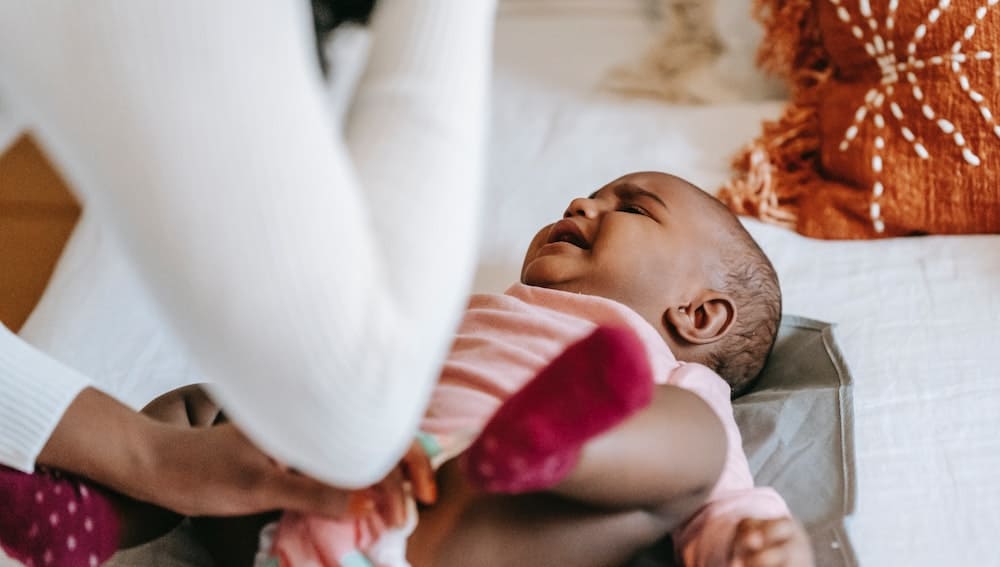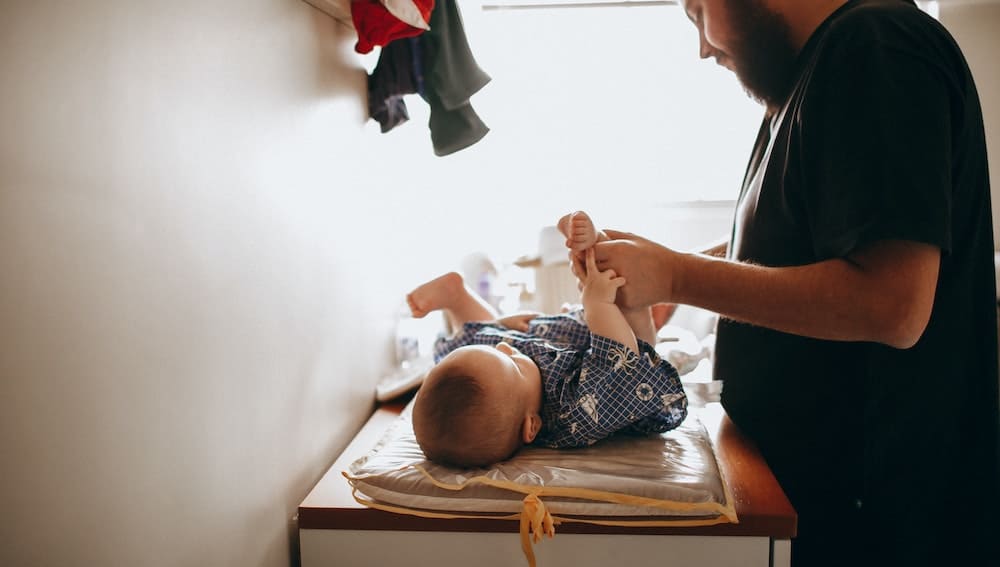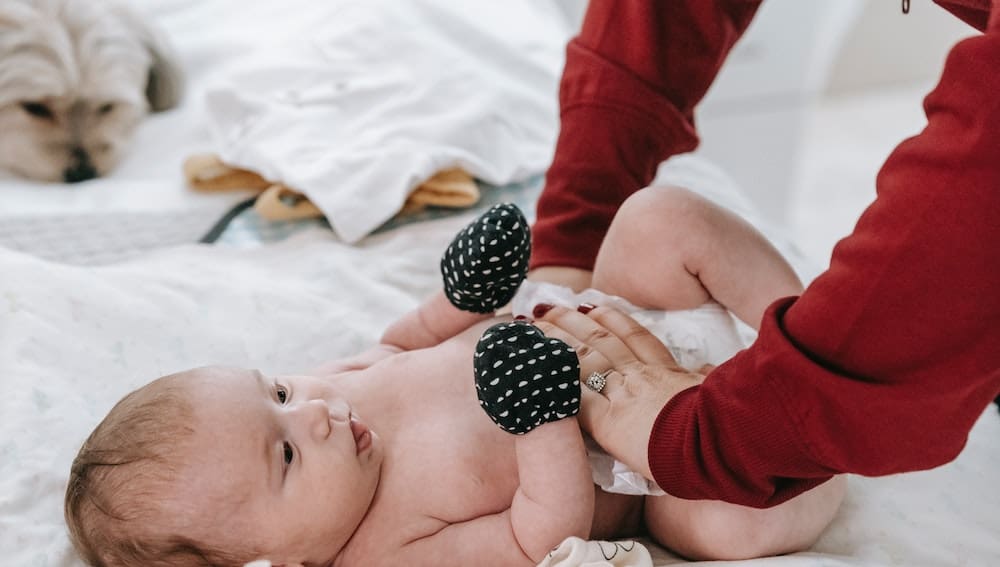Babies cry for a variety of reasons, and diaper changes are no exception. As a parent or caregiver, it can be frustrating to have your baby cry during what seems like a routine task.
However, understanding why babies cry during diaper changes can help you address the issue and create a positive experience for both you and your little one.
One reason babies may cry during diaper changes is physical discomfort. Diapers that are too tight or too loose can cause irritation or discomfort, leading to crying. Additionally, cold wipes or a cold changing surface can be uncomfortable for a baby.
Hunger can also play a role, as babies may cry when they are hungry and the act of changing their diaper can interrupt feeding time.
Key Takeaways
- Babies may cry during diaper changes due to physical discomfort or hunger.
- Creating a positive diaper change experience can help reduce crying.
- Soothing techniques, such as singing or gentle touch, can help calm a crying baby during diaper changes.
Understanding Why Babies Cry
Babies cry for many reasons, and one of them is when they are being changed. Understanding why babies cry when changing their diaper can help parents and caregivers soothe them and make the process more comfortable for both the baby and themselves.
Some of the reasons why babies cry when changing their diaper include:
- Discomfort: The baby may be uncomfortable due to the wet or dirty diaper, or the coldness of the wipes or diaper changing surface.
- Hunger: If the baby is hungry, changing their diaper may interrupt their feeding schedule, causing them to cry.
- Overstimulation: Sometimes, the process of changing a diaper can be overwhelming for a baby, especially if there are too many distractions or noises around.
- Need for attention: Some babies cry when they need attention or comfort from their parents or caregivers.
It is essential to pay attention to the baby’s cues and try to identify the reason for their crying. This can help parents and caregivers address the underlying issue and make the diaper changing process more comfortable for the baby.
Additionally, some babies may have specific preferences when it comes to diaper changing, such as the type of diaper or wipes used, the temperature of the changing surface, or the position they are held in.
Experimenting with different techniques and materials can help parents and caregivers find what works best for their baby.
In conclusion, understanding why babies cry when changing their diaper can help parents and caregivers soothe them and make the process more comfortable.
By paying attention to the baby’s cues and experimenting with different techniques and materials, parents and caregivers can find what works best for their baby and make diaper changing a smoother and less stressful experience for everyone involved.
The Role of Diaper Changes
Diaper changes are an essential part of caring for a baby’s hygiene. Changing a baby’s diaper helps to keep them clean, dry, and comfortable. However, many parents may find that their baby cries during diaper changes, making the process stressful for both the parent and the baby.
There are several reasons why a baby may cry during diaper changes. One reason is that the baby may be uncomfortable or in pain due to a dirty diaper.
Babies have sensitive skin, and a wet or dirty diaper can cause irritation and discomfort. Another reason may be that the baby is cold or uncomfortable due to the changing surface, such as a changing table.
It is important for parents to be mindful of their baby’s comfort during diaper changes. Using a soft, clean diaper and gentle wipes can help to minimize discomfort and irritation.
Additionally, using a warm changing pad or blanket can help to keep the baby warm and comfortable during the changing process.
In some cases, a baby may cry during diaper changes due to a medical condition, such as diaper rash or a urinary tract infection. If a baby continues to cry during diaper changes despite efforts to keep them comfortable, parents should consult with their pediatrician to rule out any underlying medical issues.
Overall, diaper changes play a crucial role in maintaining a baby’s hygiene and comfort. By being mindful of their baby’s needs and comfort during diaper changes, parents can help to minimize crying and make the process more comfortable for both the parent and the baby.
Physical Discomfort During Diaper Changes
One of the most common reasons why babies cry during diaper changes is due to physical discomfort.
The process of changing a diaper can be uncomfortable for babies, especially if they are lying on their back for an extended period. This can cause pressure on their back and neck, leading to discomfort and crying.
In some cases, babies may also experience stress and frustration during diaper changes. This can be due to a variety of factors, such as feeling cold or exposed, being hungry, or simply feeling uncomfortable in general.
Colic is another common cause of crying during diaper changes. Colic is a condition that affects some babies and is characterized by excessive crying and fussiness. It is not entirely clear what causes colic, but it is thought to be related to digestive issues or an immature nervous system.
In some cases, babies with spina bifida may also experience discomfort during diaper changes. Spina bifida is a birth defect that affects the spinal cord and can lead to a variety of complications, including difficulty with bladder and bowel control.
Overall, it is important for parents to be aware of the potential causes of physical discomfort during diaper changes and to take steps to minimize any discomfort their baby may be experiencing.
This can include using a soft and comfortable changing surface, keeping the room warm, and using gentle and soothing techniques to calm the baby during the process.
Hunger and Diaper Changes
It is common for babies to cry during diaper changes, and hunger may be one of the reasons why. When a baby is hungry, they may become fussy and irritable, making it difficult to change their diaper.
During a diaper change, a baby may feel exposed and vulnerable, which can add to their discomfort if they are already hungry. Hunger can also cause a baby to become impatient and frustrated, making it harder for them to sit still during a diaper change.
To avoid hunger-related crying during diaper changes, it is important to make sure the baby is well-fed before beginning the process. This can be done by feeding the baby shortly before the diaper change or offering a snack during the process.
Additionally, it may be helpful to have distractions on hand, such as toys or books, to keep the baby occupied and less focused on their hunger. Taking breaks during the diaper change to offer a feeding or snack can also help alleviate hunger-related crying.
Overall, hunger can be a contributing factor to a baby’s crying during diaper changes. By addressing this issue through proper feeding and distraction techniques, parents can help make the diaper changing process smoother and more comfortable for their baby.
Creating a Positive Diaper Change Experience
Changing a baby’s diaper can be a challenging task, especially when the baby starts crying or fussing during the process. However, creating a positive diaper change experience can help make the process smoother for both the baby and the caregiver.
One way to create a positive experience is by establishing a routine. Babies thrive on routines, and having a set time and place for diaper changes can help them feel more secure and less anxious.
Additionally, using a consistent method for changing the diaper can help the baby know what to expect and reduce their stress levels.
Praising the baby during the diaper change can also help create a positive experience. Using positive reinforcement, such as saying “good job” or “you’re doing great,” can help the baby feel more confident and secure during the process.
Distractions can also be helpful during diaper changes. Providing a mobile or toy for the baby to play with can help keep them occupied and less likely to fuss or cry.
Overall, creating a positive diaper change experience involves establishing a routine, using positive reinforcement, and providing distractions when necessary.
By doing so, caregivers can help reduce the stress and anxiety associated with diaper changes and create a more positive experience for both the baby and themselves.
Soothing Techniques for a Crying Baby
When a baby cries during a diaper change, it can be a stressful experience for both the baby and the caregiver. Fortunately, there are several techniques that can help soothe a crying baby during diaper changes.
One effective technique is to offer a pacifier to the baby. The sucking motion can help to calm the baby down and distract them from the diaper change. It can also help to keep the baby’s mouth occupied, preventing them from crying or fussing.
Holding the baby can also be a helpful technique. The caregiver can pick the baby up and hold them close, providing comfort and reassurance. This can help the baby feel safe and secure during the diaper change.
Rocking the baby back and forth can also be a soothing technique. The gentle motion can help to calm the baby down and distract them from the diaper change.
Swaddling the baby can also be an effective technique. Wrapping the baby snugly in a blanket can help them feel secure and calm. This can also prevent the baby from moving around too much during the diaper change, making it easier to complete the task.
Finally, white noise can be a helpful technique for soothing a crying baby during a diaper change. White noise machines or apps can provide a consistent, soothing sound that can help to calm the baby down and distract them from the diaper change.
Overall, there are several techniques that can help soothe a crying baby during a diaper change. Caregivers can try different techniques to find what works best for their baby.
Understanding the Role of the Caregiver
When it comes to changing a baby’s diaper, caregivers play a crucial role in ensuring that the experience is as smooth and stress-free as possible. Babies can be easily overwhelmed by the sensations and movements associated with diaper changes, and they may cry or become fussy as a result.
However, by understanding their role in the process and taking steps to prepare themselves and the baby, caregivers can help to minimize distress and create a more positive experience.
First and foremost, caregivers should be aware of their own emotional state when approaching a diaper change. If they are feeling anxious, rushed, or frustrated, this can easily transfer to the baby and make the experience more difficult for both parties.
Taking a few deep breaths, centering oneself, and reminding oneself of the importance of remaining calm and patient can go a long way in creating a positive atmosphere.
Additionally, caregivers should make sure that they have all of the necessary supplies and equipment on hand before beginning the diaper change. This can help to minimize the amount of time that the baby spends in a vulnerable and uncomfortable position, reducing the risk of crying or fussiness.
Having a clean, quiet, and well-lit space to perform the change can also be helpful in creating a calm and soothing environment.
Finally, caregivers should be attuned to the baby’s cues and needs throughout the diaper change process. This may involve checking in with the baby verbally, providing soothing touch or vocalizations, or simply taking breaks as needed to allow the baby to settle.
By remaining present and responsive to the baby’s needs, caregivers can help to build trust and create a sense of safety and security during diaper changes.
Related post: Changing Diapers in Public
Frequently Asked Questions
How can I make diaper changes less stressful for my baby?
There are several things you can do to make diaper changes less stressful for your baby. First, make sure the diaper changing area is warm and comfortable.
You can use a changing pad or towel to cushion your baby’s back and head. Second, try to distract your baby with toys or songs. Third, be gentle and talk to your baby in a soothing voice.
What are some common reasons why babies cry during diaper changes?
Babies cry during diaper changes for several reasons. They may be cold, uncomfortable, hungry, or tired. They may also be upset because they don’t like being interrupted or because they are experiencing discomfort from diaper rash or other skin irritation.
Is it normal for babies to cry during diaper changes?
Yes, it is normal for babies to cry during diaper changes. Diaper changes can be uncomfortable and disruptive for babies, especially if they are hungry or tired. However, if your baby is crying excessively or seems to be in pain, you should consult your pediatrician.
What are some tips for calming a crying baby during diaper changes?
There are several things you can do to calm a crying baby during diaper changes. First, try to distract your baby with toys or songs. Second, be gentle and talk to your baby in a soothing voice.
Third, try to complete the diaper change as quickly as possible. Fourth, consider using a pacifier or other soothing technique.
How can I prevent my baby from crying during diaper changes?
To prevent your baby from crying during diaper changes, try to make the experience as comfortable and stress-free as possible. This may involve using a warm, comfortable changing area, distracting your baby with toys or songs, and being gentle and soothing.
You may also want to consider changing your baby’s diaper more frequently to prevent discomfort from wetness or diaper rash.
What are some signs that my baby may be uncomfortable during diaper changes?
Some signs that your baby may be uncomfortable during diaper changes include crying, fussiness, squirming, and arching their back.
Your baby may also seem restless or irritable during diaper changes. If you notice any of these signs, try to make the diaper changing experience more comfortable and soothing for your baby.
Also read: Baby Crying While Drinking Bottle

Iesha is a loving mother of 2 beautiful children. She’s an active parent who enjoys indoor and outdoor adventures with her family. Her mission is to share practical and realistic parenting advice to help the parenting community becoming stronger.




